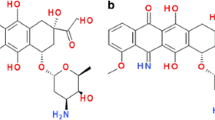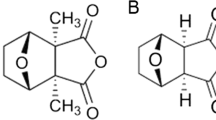Summary
The influence of ranitidine on the pharmacokinetics and toxicity of doxorubicin was studied in six female New Zealand white rabbits. Plasma pharmacokinetic data were first obtained from rabbits given 3 mg/kg doxorubicin. After 1 month, the same rabbits were treated with ranitidine, 2.5 mg/kg or 25 mg/kg, before and during doxorubicin administration. The plasma doxorubicin assays to determine pharmacokinetic parameters were repeated. Drug toxicity was evaluated using complete blood counts, and hepatic function was measured using a 14C-aminopyrine breath test. High-dose ranitidine increased the total exposure to doxorubicin (area under the curve of doxorubicin alone =1.44±0.88 μ M·h/ml vs 4.49±2.35 μM·hr/ml for doxorubicin given with high-dose ranitidine; P=0.06). Low-dose ranitidine did not alter doxorubicin pharmacokinetics. Exposure to doxorubicinol was altered by either high-dose or low-dose ranitidine. 14C-Aminopyrine half-life was altered by a raniditine dose of 25 mg/kg (aminopyrine half-life after placebo control =97±6 min as against aminopyrine half-life after ranitidine =121±7 min; mean±SEM; P<0.02). Low-dose ranitidine did not exacerbate doxorubicin-induced myelosuppression. High-dose ranitidine enhanced doxorubicin-induced erythroid suppression while sparing the myeloid series. At cytochrome P-450-inhibitory doses, ranitidine's effects upon doxorubicin plasma pharmacokinetics are similar to those previously seen with cimetidine. These changes did not appear to alter drug detoxification and are not related to microsomal inhibition of doxorubicin detoxification. Low doses of ranitidine do not alter doxorubicin plasma pharmacokinetics or toxicity in rabbits.
Similar content being viewed by others
References
Bachur NR, Gordon SL, Gee MY, Kon H (1979) NADPH cytochrome P-450 reductase activation of quinone anticancer agents to free radicals. Proc Natl Acad Sci USA 76: 954
Benet LZ, Babeazzi RL (1979) Noncompartmental determination of the steady-state volume of distribution. J Pharm Sci 68: 1071
Breen KJ, Bury R, Desmond PV, Mashford ML, Morphett B, Westwood B, Shaw RG (1982) Effects of cimetidine and ranitidine on hepatic drug metabolism. Clin Pharmacol Ther 31: 297
Brenner DE, Galloway S, Cooper J, Noone R, Hande KR (1985) Improved high performance liquid chromatography assay of doxorubicin: comparison of thin-layer chromatography. Cancer Chemother Pharmacol 14: 139
Brenner DE, Collins JC, Hande KR (1986) The effects of cimetidine upon plasma pharmacokinetics of doxorubicin in rabbits. Cancer Chemother Pharmacol 18: 219
Brenner DE, Anthony LB, Halter S, Harris NL, Collins JC, Hande KR (1987) Effect of allyl alcohol-induced sublethal hepatic damage upon doxorubicin metabolism and toxicity in rabbits. Cancer Res 47: 3259
Brenner LO (1986) Agranulocytosis and ranitidine. Ann Intern Med 104: 896
Chan KK, Chlebowski RT, Tong M, Chen G, Gross JF, Bateman JR (1980) Clinical pharmacokinetics of adriamycin in hepatoma patients with cirrhosis. Cancer Res 40: 1263
Daly MJ, Humphray JM, Stables R (1980) Inhibition of gastric acid secretion in the dog by the H2-receptor antagonists ranitidine, cimetidine, and metiamide. Gut 21: 408
Danhof M, Breimer DD (1979) Studies on the different metabolic pathways of antipyrine in man: I. Oral administration of 250, 500 and 1000 mg to healthy volunteers. Br J Clin Pharmacol 8: 529
Desmond PV, Branch RA, Calder I, Schenker S (1980) Comparison of [14C]phenacetin and amino [14C]pyrine breath tests after acute and chronic liver injury in the rat. Proc Soc Exp Biol Med 164: 173
Dessypris EN, Brenner DE, Hande KR (1986) Toxicology of adriamycin metabolites to human marrow erythroid and myeloid progenitors in vitro. Cancer Treat Rep 70: 487
DiPalma JR (1971) Drill's pharmacology in medicine, 4th edn. McGraw-Hill, New York
Dixon WJ, Massey FJ (1969) Introduction to statistical, analyses, 3rd edn. McGraw-Hill, New York
Donn KH, Powell JR, Rogers JF, Eshelman FN (1984) The influence of H2-receptor antagonists on steady-state concentrations of propanolol and 4-hydroxypropanolol. J Clin Pharmacol 24: 500
Douglas WW (1985) Antacoids. In: Gilman AG, Goodman LS, Kall TW, Murad F (eds) The pharmacologic basis of therapeutics. MacMillan, New York, pp 624–627
Felsted RL, Bachur NR (1980) Mammalian carboxyl reductase. Drug Metab Rev 11: 1
Freireich EJ, Gehan EA, Rall DP, Schmidt LH, Skipper HE (1966) Quantitative comparison of toxicity of anticancer agents in mouse, rat, hamster, dog, monkey and man. Cancer Chemother Rep 50: 219
Freston JW (1982) Cimetidine: II. Adverse reactions and problems of use. Ann Intern Med 97: 728
Glaxo Inc. (1984) Zantac Injection, Product Information Sheet. Glaxo, Research Triangle Park, NC
Henry DA, MacDonald IA, Kitchinghan G, Bill GD, Langman MJS (1980) Cimetidine and ranitidine: comparison of effects on hepatic drug metabolism. Br Med J 281: 775
Hepner GW, Vesell ES (1974) Assessment of aminopyrine metabolism in man after oral administration of 14C-aminopyrine. N Engl J Med 291: 1384
Hepner, GW, Uhlin SR, Lipton A, Harvey HA, Rohrer GV (1976) Abnormal aminopyrine metabolism in patients with hepatic neoplasm. Detection by breath test. JAMA 235: 1587
Hoympa AM, Schenker S (1982) Major drug interactions: effect of liver disease, alcohol and malnutrition. Annu Rev Med 33: 113
Kirch W, Hoensch H, Janisch HD (1984) Interactions and noninteractions with ranitidine. Clin Pharmacokinet 9: 493
Oki T, Komiyama T, Tone H, Inui T (1977) Reductive cleavage of anthracycline glycosides by microsomal NADPH cytochrome c reductase. J Antibiot (Tokyo) 30: 613
Takanashi S, Bachur NR (1976) Adriamycin metabolism in man: evidence from urinary metabolites. Drug Metab Dispos 4: 79
Teunissen MWF, Spoelstra P, Koch CW, Weeda B, Van Duyn W, Janssens AR, Breimer DD (1984) Antipyrine clearance and metabolite formation in patients with alcoholic cirrhosis. Br J Clin Pharmacol 18: 707
Warren RD, Bender RA (1977) Drug interactions with antineoplastic agents. Cancer Treat Rep 61: 1231
Author information
Authors and Affiliations
Additional information
Grant support: Glaxo Inc., Veterans Administration, NIH BRSG RR-05424, NIH Grant RR-00095, Clinical Research Center. American Cancer Society Institutional Grant IN25V
Rights and permissions
About this article
Cite this article
Harris, N.L., Brenner, D.E., Anthony, L.B. et al. The influence of ranitidine on the pharmacokinetics and toxicity of doxorubicin in rabbits. Cancer Chemother. Pharmacol. 21, 323–328 (1988). https://doi.org/10.1007/BF00264199
Received:
Accepted:
Issue Date:
DOI: https://doi.org/10.1007/BF00264199




